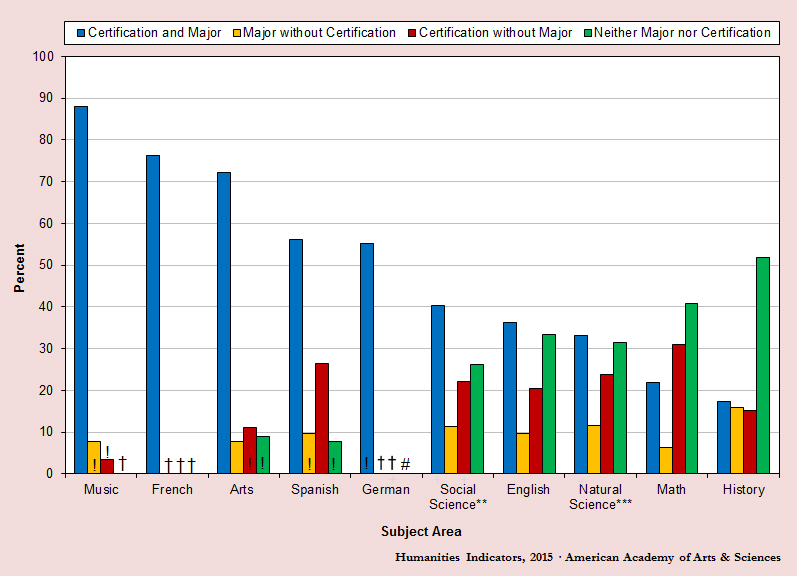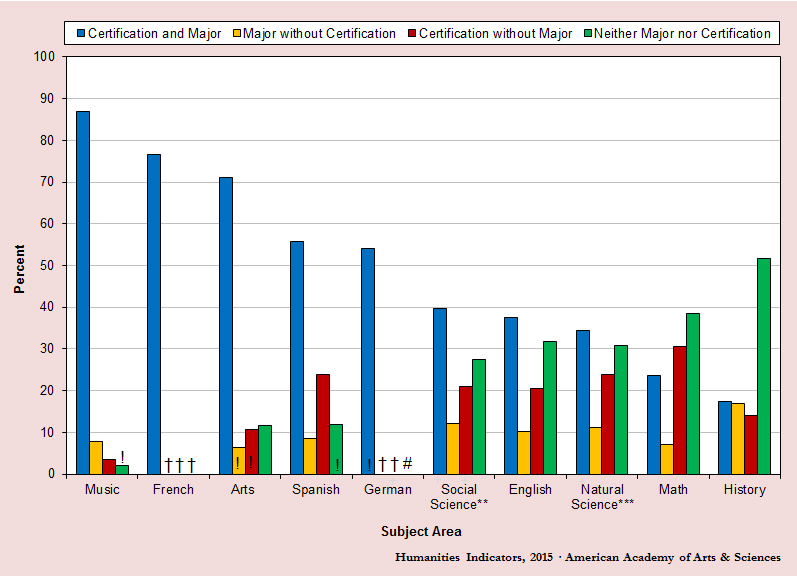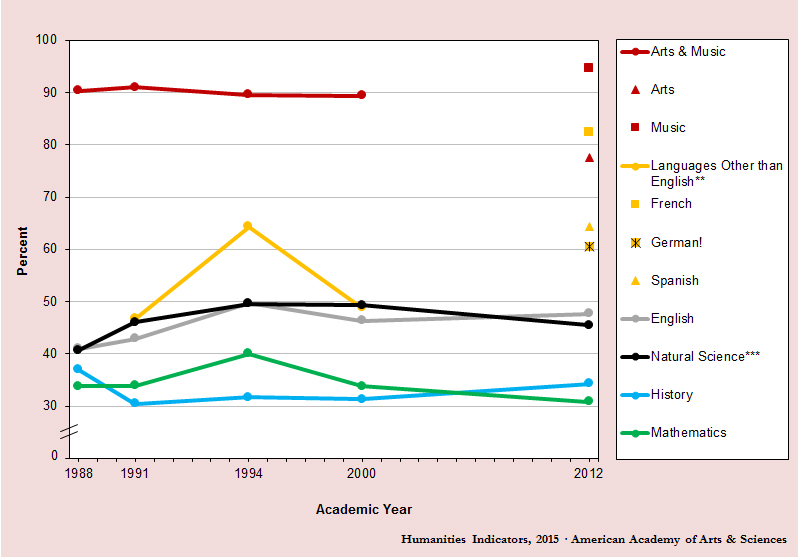Qualifications of Humanities Teachers in U.S. Public Middle Schools
- Results from the 2012 SASS show that the academic credentials held by public middle school teachers differ widely by subject area (Indicator I-20a). In music, 88% of departmentalized teachers held a postsecondary degree in the field and certification to teach the subject. Only 22% of math teachers and 17% of history teachers had both credentials. Very few music teachers lacked both certification and a degree in the field, while 41% percent of the math teachers and 52% of the history teachers lacked both credentials (note that not all states offer teacher certification in history). The data suggest that some history teachers without a major or certification in history hold credentials in another social science. (NCES, like several other data sources on which the Humanities Indicators relies, treats history as a social science discipline rather than as one within the humanities; please see the Note on Credentials of “Social Science” Teachers in Public Middle Schools for further explanation of the relationship between the “history” and “social science” categories.)
- In the languages, 76% of teachers of French had both a college major and certification in the discipline, as compared to 56% for Spanish, 55% for German, and 36% for English.
- Due to variation in class size and the fact that some middle school teachers provide instruction in multiple subjects, the share of teachers with a given qualification and the share of students taught a given subject by teachers with such a qualification can differ. In every subject, however, the percentage of students in the classroom of a departmentalized teacher who had both a credential and a postsecondary degree in the subject was within two percentage points of the percentage of such teachers with both qualifications (Indicator I-20b). In 2012, less than half of the students in classes in English, history, math, and the natural sciences had teachers with a degree in the subject—a substantially smaller share than at the high school level (Indicator I-20c).
- The SASS report for 2012 provides the first estimate of teacher qualifications at the middle school level since 2000, though only the data regarding the correspondence between the teacher’s field of degree and the subject taught are comparable with previous years. The proportion of middle school students taught English by a teacher with a degree in the subject increased from 41% in 1988 to 48% in 2012. The increase since 1988 was similar to developments in the natural sciences both at the middle school level and in the nation’s public high schools.
- Despite a small increase from 2000 to 2012, the percentage of middle schoolers taught history by a teacher holding a postsecondary degree in the discipline (34%) remained below the 1988 level, but surpassed the comparable percentage in mathematics classes in 2012 (31%).
I-20a: Percentage of Departmentalized Public Middle School Teachers* with Certification and a Postsecondary Degree in the Subject of Their Main Teaching Assignment, for Selected Subjects, 2011–2012

* Middle school teachers are those who taught students in grades 5–9 and did not teach any students in grades 10–12. Teachers who identified themselves as elementary or special education teachers were excluded.
** The Social Science category includes (and treats as credentialed in social science) history teachers who have a postsecondary degree and/or certification in general social science (including social studies) or a constituent discipline. (The collector of these data treats history as a social science discipline rather than as one within the humanities field.) See the Note on the Credentials of “Social Science” Teachers in Public Middle Schools for further explanation of the relationship between the “history” and “social science” categories.
*** The Natural Science category aggregates teachers of general science and specific science disciplines (e.g., chemistry). Such teachers are considered to hold a credential in the subject they teach if the degree or certification is in general science or a specific science discipline.
! Interpret data with caution. The standard error for this estimate is between 30% and 50% of the estimated value.
† The population in this category was too small to achieve a reliable estimate.
# Estimate rounds to zero.
Source: Stéphane Baldi, Catharine Warner-Griffin, and Chrystine Tadler, Education and Certification Qualifications of Public Middle Grades Teachers of Selected Subjects: Evidence from the 2011–12 Schools and Staffing Survey (Washington, DC: U.S. Government Printing Office, 2015), 21 table 2.
Per the report, most of the teachers in U.S. public middle schools (“defined as those who teach grades 5–8 but no grades lower than 5 and no grades higher than 9”) were classified as departmentalized. Departmentalized teachers “are those who instruct several classes of different students most or all of the day in one or more subjects.” The SASS report for 2012 estimates that there were 183,600 departmentalized middle school teachers in the humanities disciplines of English, French, German, Spanish, and history (with 139,100 in English, 3,600 in French, 500 in German, 10,900 in Spanish, and 29,500 in history). In comparison, the report estimates only 13,100 English teachers classified as nondepartmentalized, with no estimates for the other humanities subjects. The nation’s middle school English instructors taught 14,275,700 students. French teachers served 477,900 students; German teachers, 56,200; and Spanish teachers, 1,552,000. History teachers were responsible for the learning of 3,909,400 young people.
Please see the Note on the Credentials of “Social Science” Teachers in Public Middle Schools for an explanation of the relationship between the history and social science categories included in the graph.
I-20b: Percentage of Public Middle School Students in Classes Taught by a Departmentalized Instructor* with Certification and a Postsecondary Degree in That Subject, for Selected Subjects, 2011–2012

* Middle school teachers are those who taught students in grades 5–9 and did not teach any students in grades 10–12. Teachers who identified themselves as elementary or special education teachers were excluded.
** The Social Science category includes (and treats as credentialed in social science) history teachers who have a postsecondary degree and/or certification in general social science (including social studies) or a constituent discipline. (The collector of these data treats history as a social science discipline rather than as one within the humanities field.) See the Note on Credentials of “Social Science” Teachers in Public Middle Schools for further explanation of the relationship between the “history” and “social science” categories.
*** The Natural Science category aggregates teachers of general science and specific science disciplines (e.g., chemistry). Such teachers are considered to hold a credential in the subject they teach if the degree or certification is in general science or a specific science discipline.
! Interpret data with caution. The standard error for this estimate is between 30% and 50% of the estimated value.
† The population in this category was too small to achieve a reliable estimate.
# Estimate rounds to zero.
Source: Stéphane Baldi, Catharine Warner-Griffin, and Chrystine Tadler, Education and Certification Qualifications of Public Middle Grades Teachers of Selected Subjects: Evidence from the 2011–12 Schools and Staffing Survey (Washington, DC: U.S. Government Printing Office, 2015), 29 table 25.
Per the report, most of the teachers in U.S. public middle schools (“defined as those who teach grades 5–8 but no grades lower than 5 and no grades higher than 9”) were classified as departmentalized. Departmentalized teachers “are those who instruct several classes of different students most or all of the day in one or more subjects.” The SASS report for 2012 estimates that there were 183,600 departmentalized middle school teachers in the humanities disciplines of English, French, German, Spanish, and history (with 139,100 in English, 3,600 in French, 500 in German, 10,900 in Spanish, and 29,500 in history). In comparison, the report estimates only 13,100 English teachers classified as nondepartmentalized, with no estimates for the other humanities subjects. The nation’s English middle school instructors taught 14,275,700 students. French teachers served 477,900 students; German teachers, 56,200; and Spanish teachers, 1,552,000. History teachers were responsible for the learning of 3,909,400 young people.
Please see the Note on the Credentials of “Social Science” Teachers in Public Middle Schools for an explanation of the relationship between the history and social science categories included in the graph.
I-20c: Percentage of Public Middle School Students in Classes Taught by a Departmentalized Instructor* with a Degree in That Subject, By Subject, 1988–2012

* Middle school teachers are those who taught students in grades 5–9 and did not teach any students in grades 10–12. Teachers who identified themselves as elementary or special education teachers were excluded.
** Data not collected for this subject in 1988.
*** The Natural Science category aggregates teachers of general science and specific science disciplines (e.g., chemistry). Such teachers are considered to hold a credential in the subject they teach if the degree or certification is in general science or a specific science discipline.
! Interpret data with caution. The standard error for this estimate is between 30% and 50% of the estimated value.
Source: For years 1988–2000: Marilyn M. Seastrom et al., Qualifications of the Public School Teacher Workforce: Prevalence of Out-of-Field Teaching 1987–88 to 1999–2000, Statistical Analysis Report NCES 2002-603 Revised (Washington, DC: National Center for Education Statistics, 2002), 61 table B-8.
For 2012: Stéphane Baldi, Catharine Warner-Griffin, and Chrystine Tadler, Education and Certification Qualifications of Public Middle Grades Teachers of Selected Subjects: Evidence from the 2011–12 Schools and Staffing Survey (Washington, DC: U.S. Government Printing Office, 2015), 29 table 25.
In 2003–2004, the National Center for Education Statistics (NCES) changed the method by which it collects teacher certification data: “In an effort to improve the reliability of the items, separate questions were used to ask about main teaching assignment and certification. Respondents were first asked to identify the subject code for their main assignment and then, in a later section of the survey, to identify subject codes for all subjects covered by the certification(s) they held. A determination of whether or not teachers were certified in their main assignment is up to the analyst; the analyst is able to match the course taught with certification areas, rather than rely on teacher self-reports.” (Beth A. Morton et al., Education and Certification Qualifications of Departmentalized Public High School–Level Teachers of Core Subjects: Evidence from the 2003–04 Schools and Staffing Survey, Statistical Analysis Report NCES 2008-338 [Washington, DC: National Center for Education Statistics, 2008], 57–58.)
Due to the resulting noncomparability of these and subsequently collected certification data with the information collected in previous years, the trend analysis presented here focuses solely on teachers’ educational backgrounds. Per the report, most of the teachers in U.S. public middle schools (“defined as those who teach grades 5–8 but no grades lower than 5 and no grades higher than 9”) were classified as departmentalized. Departmentalized teachers “are those who instruct several classes of different students most or all of the day in one or more subjects.”
The SASS report for 2012 estimates that there were 183,600 departmentalized middle school teachers in the humanities disciplines of English, French, German, Spanish, and history (with 139,100 in English, 3,600 in French, 500 in German, 10,900 in Spanish, and 29,500 in history). In comparison, the report estimates only 13,100 English teachers classified as nondepartmentalized, with no estimates for the other humanities subjects. The nation’s English middle school instructors taught 14,275,700 students. French teachers served 477,900 students; German teachers, 56,200; and Spanish teachers, 1,552,000. History teachers were responsible for the learning of 3,909,400 young people.
Please see the Note on the Credentials of “Social Science” Teachers in Public Middle Schools for an explanation of the relationship between the history and social science categories included in the graph.

